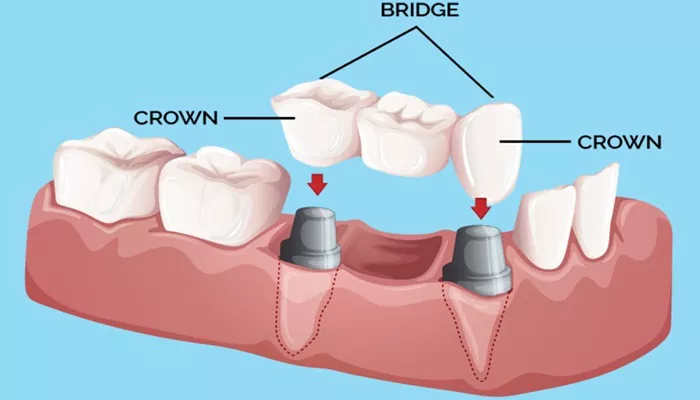Dental crowns are a common restorative treatment designed to restore the function and appearance of damaged or decayed teeth. If you have dental insurance, understanding how much a crown will cost you can help you plan your budget and avoid unexpected expenses. This article provides a detailed overview of the costs associated with crowns when you have dental insurance, including factors that affect pricing, typical coverage, and tips for maximizing your benefits.
Understanding Dental Crowns
A dental crown is a cap placed over a tooth to restore its shape, size, strength, and appearance. Crowns are often recommended for teeth that are severely decayed, cracked, or have undergone root canal treatment. They can be made from various materials, including porcelain, metal, or a combination of both.
Types of Crowns:
Porcelain Crowns: These crowns blend well with natural teeth and are typically used for front teeth due to their aesthetic appeal.
Metal Crowns: Made from gold, platinum, or other metals, these crowns are known for their durability and are usually used for back teeth.
Porcelain-Fused-to-Metal Crowns: These provide the strength of metal with the appearance of porcelain, making them a popular choice for both aesthetics and durability.
SEE ALSO: Is Cypress Dental Insurance Good?
Cost of Dental Crowns Without Insurance
Before delving into how dental insurance affects the cost, it’s essential to understand the typical out-of-pocket cost for crowns without insurance. On average, dental crowns can range from $800 to $3,000 per tooth, depending on factors like the material used, the location of the dental practice, and the complexity of the procedure.
How Dental Insurance Affects the Cost of Crowns
Dental insurance can significantly reduce the cost of a crown, but the extent of the coverage varies among insurance plans.
Here’s what you need to know:
1. Coverage Limits
Most dental insurance plans cover a percentage of the cost of a crown, typically ranging from 50% to 80%. This means if you have a plan that covers 50% of the cost, and your crown costs $1,200, you would pay $600 out-of-pocket.
2. Annual Maximums
Dental insurance plans often have an annual maximum limit, which is the maximum amount the insurance company will pay for dental services within a calendar year. This limit usually ranges from $1,000 to $2,000. If you need a crown and other dental work within the same year, the total cost could exceed your annual maximum, leaving you responsible for the remaining balance.
3. Deductibles and Copayments
Many dental insurance plans require you to pay a deductible before they start covering costs. Additionally, you might be responsible for copayments or coinsurance, which is the portion of the cost you pay after the insurance has contributed its share.
4. Type of Plan
The type of dental insurance plan you have can also impact how much you pay for a crown. There are several types of dental plans:
Preferred Provider Organization (PPO): PPO plans offer a list of in-network dentists who have agreed to discounted rates. If you visit an in-network provider, you’ll likely pay less out-of-pocket.
Health Maintenance Organization (HMO): HMO plans typically have lower premiums and out-of-pocket costs but require you to choose a primary care dentist and obtain referrals for specialists.
Fee-for-Service (Indemnity): This type of plan allows you to visit any dentist and is less restrictive but often comes with higher premiums and out-of-pocket costs.
Maximizing Your Dental Insurance Benefits
To make the most of your dental insurance when getting a crown, consider the following tips:
1. Review Your Policy
Before proceeding with treatment, review your dental insurance policy to understand your coverage limits, deductibles, and copayments. Knowing these details will help you estimate your out-of-pocket expenses and avoid surprises.
2. Verify In-Network Providers
Check if your dentist is within your insurance network. Visiting an in-network provider can save you money, as they have agreed to discounted rates with the insurance company.
3. Get Pre-Authorization
Many insurance companies require pre-authorization for certain procedures, including crowns. Obtain pre-authorization to confirm your coverage and get an estimate of your out-of-pocket costs before starting the treatment.
4. Spread Out Your Treatments
If your dental work exceeds your annual maximum, consider scheduling treatments in different calendar years to maximize your insurance benefits.
5. Explore Financing Options
If the cost of the crown exceeds what you can afford out-of-pocket, ask your dentist about financing options. Many dental practices offer payment plans or third-party financing to help manage costs.
Conclusion
Dental crowns are an essential treatment for restoring damaged teeth, and having dental insurance can make a significant difference in managing the cost. By understanding how your insurance plan works and taking proactivesteps to maximize your benefits, you can reduce your out-of-pocket expenses and receive the care you need.

